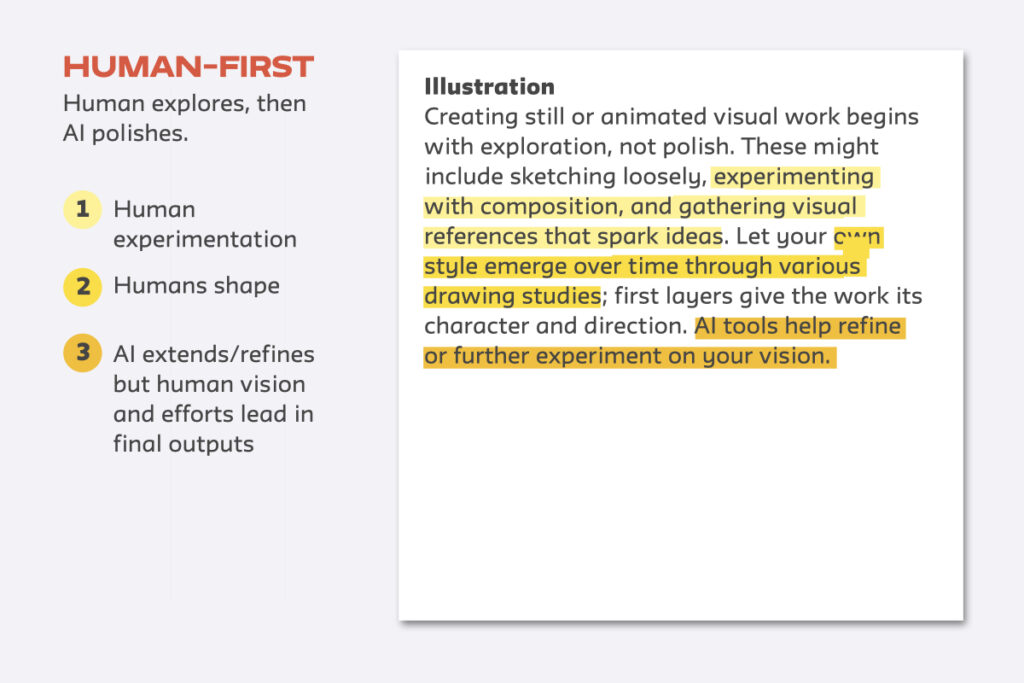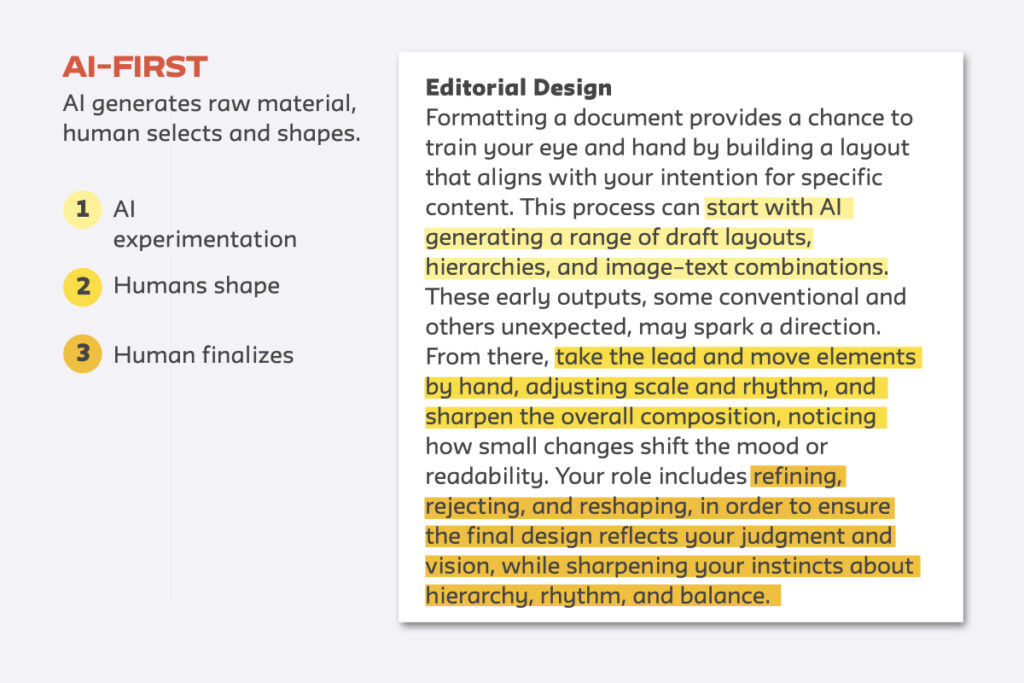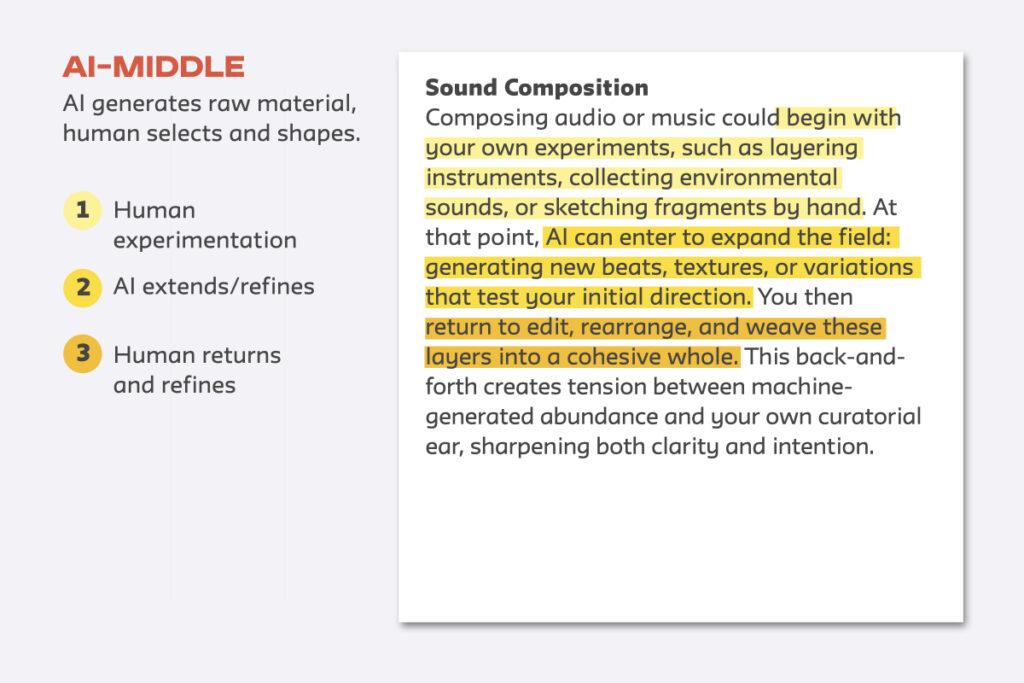AI + Creative Friction
We believe that our work as educators, students, and practitioners is more than a means to an end. It is a vehicle for becoming better thinkers, better collaborators, and better makers. AI can support that journey, but only if we use it with intention, integrity, curiosity, and care. At most, AI can be a partner in our creative process. One that requires shaping, scrutiny, and restraint.
AI can enhance, not replace, creative education. The goal of creative education is to develop our own voices and thinking. If AI use dilutes that, it undermines the purpose of the work. AI can be one element in a larger process of developing purposeful work, not the solution itself. You can think of AI like a spice—it can deepen complexity or shift a flavor, but not dominate the meal. Let your own hand, mind, and voice lead.
The approach outlined below builds on these values to help the School of Design Strategies’ community determine whether and when to incorporate AI into their creative processes. Instructors using these may adapt them to fit the particular goals of their courses.
Context-Specific AI Use
The use of AI can look very different across courses, programs, and disciplines, and those differences are important. Some skills and creative instincts only grow through fully manual effort—sketching, drafting, prototyping. Talk openly with your peers and instructors about the best way to help everyone learn how to use AI in ways that fit the practice you are undertaking.
Seeing AI as a complement—not a replacement—to core skills ensures that our education stays grounded in doing, making, and thinking. These conversations create clarity and help maintain the balance between hands-on practice and digital assistance, so that AI enhances rather than erodes the craft and judgment each discipline values.
Using with Intention, Reflection, and Awareness of Planetary Costs
Before using AI, articulate what you hope to achieve by using it. After using it, reflect on its impact on your thinking, work, and growth.
The uncritical use of a method leads to uncritical results. If you do not clearly define what you’re trying to do—and reflect on what AI has done for you—you risk letting the tool shape the outcome without your input. More than just a technical resource, AI systems also carry significant environmental costs. The high energy and water consumption of these systems mean that every interaction should be weighed with care and purpose. Responsible use implies responsible stewardship.
Keeping Alternatives in Mind
While it might seem as if AI is unavoidable, it isn’t. This feeling is the result of a branding exercise by tech companies that produce AI systems to encourage continuous engagement and collect your data. Choosing not to use AI is not falling behind; it’s often the most radical and generative choice you can make to keep your instincts sharp.
Some alternatives that might boost creativity include using pen and paper during writing, drawing, notetaking, and generating ideas, reading sources found in The New School’s library, and doing your own first-order research by ‘going to the field’ and asking questions, writing down insights, taking pictures of or sketching out your observations. If you’re feeling stuck, refocus your attention by taking a walk or using a preferred method to realign your attention, rather than giving it to an AI system. You can also remove AI-generated results from search by adding ‘-AI’ (or any term you like to scramble results) to your online query, which is particularly helpful in mitigating the unwanted and wasteful energy and water use that AI is known to generate.
Considering Sources and Cultural Contexts
AI is built on data, often scraped without the consent of the individuals it represents and without pay. Be mindful of the ethical implications and the implications for fair compensation of these practices. Critically examine the sources, aesthetics, and assumptions behind generated outputs.
AI systems are trained on vast datasets, which include uncredited work by artists, writers, and communities, many of whom never consented to this use. Using AI outputs without awareness or attribution perpetuates extractive and exploitative patterns. It disenfranchises the very people who produce the knowledge that makes these systems valuable in the first place. Additionally, AI models reinforce dominant narratives and often encode bias. Without human judgment, these outputs can easily misrepresent people, flatten nuance, or cause harm.
Disclosing Use
Use of AI should be acknowledged and documented. Students, faculty, and researchers should clearly indicate how AI was utilized, what was accepted or rejected, and how it influenced the final work.
Authorship means responsibility—not only for your final product, but also for the process that led to it. Failing to disclose AI use obscures your contributions, and short-circuits your ability to reflect on the creative decisions you made—or let a system make for you. It also hinders educators’ ability to provide relevant, meaningful critique. Disclosure is not only about academic honesty; it’s about intellectual ownership. If AI was involved in the production of any graded work, and this use is not clearly documented, your instructor may consider the work to be plagiarized. In Appendix B, find tags that are designed to help you disclose at which stage you used AI.
Creative Activity [humans only / LLM / LLM + humans]
This tag format is designed to help you disclose at which stages you have used AI. They will also help you demonstrate your skills in using AI tools in a granular and purposeful way. Come up with your own tag following this format and locate the tag in a clear location. Note: “LLM refers to Large Langage Model, which is AI system designed to understand, process, and generate human-like outputs based on vast amounts of data.
Framing for Creative Friction
Struggle, iteration, and ambiguity are an important part of the creative process. AI can assist, but it should not eliminate the moments that lead to meaningful discovery.
If you use AI to smooth over the challenges in your creative process, you might skip the moments when new insights emerge. Discovery often happens during detours, false starts, or temporary confusion. These experiences are not obstacles. They are opportunities to cultivate your perspective and deepen your understanding. Removing that discomfort removes the potential for deep learning. In Appendix A, find an incomplete set of activities that our community members practice, and how existing forms of creative friction might incorporate AI technologies. Actively incorporating these kinds of approaches into our processes can better prepare us for the rapid changes that are occurring in our disciplines.
Creative Friction results from a deliberate mix of methods that aims to help us deepen our criticality, creativity, and growth by selectively inviting AI into our process.
Examples of Creative Friction
Each creative field can involve a range of activities and approaches to creative friction, which can deepen learning. The examples listed here are simplified ways to incorporate creative friction into these particular activities.



Readings
Amrute, Sareeta (2025). “Thinking the Unthinkable in AI: Four Hegemonic Ways of Seeing AI and Five Majority World Ways to Move Beyond Them.” Antipode. https://doi.org/10.1111/anti.70051
Burnett, D. Graham (2025, April 26). “Will the Humanities Survive Artificial Intelligence?” The New Yorker. https://www.newyorker.com/culture/the-weekend-essay/will-the-humanities-survive-artificial-intelligence
Chaykla, Kyle (2025, June 25). “AI Is Homogenizing Our Thoughts.” The New Yorker.
https://www.newyorker.com/culture/infinite-scroll/ai-is-homogenizing-our-thoughts
Chiang, Ted (2023, February 9). “ChatGPT Is a Blurry JPEG of the Web.” The New Yorker. https://www.newyorker.com/tech/annals-of-technology/chatgpt-is-a-blurry-jpeg-of-the-web
Cohen, Jason (2024, October 31). “How to Remove AI From Your Google Search Results.” PC Magazine. https://www.pcmag.com/how-to/how-to-remove-ai-from-your-google-search-results
Gebrekidan, Fasica Berhane (2024). “Content Moderation: The Harrowing, Traumatizing Job That Left Many African Data Workers with Mental Health Issues and Drug Dependency.” In The Data Workers’ Inquiry, edited by Milagros Miceli, Adio Dinika, Krystal Kauffman, Camilla Salim Wagner, and Laurenz Sachenbacher. Creative Commons BY 4.0. https://data-workers.org/fasica
McMenamin, Lex (2025, May 7). “ChatGPT Is Everywhere—Why Aren’t We Talking About Its Environmental Costs.” Teen Vogue. https://www.teenvogue.com/story/chatgpt-is-everywhere-environmental-costs-oped
O’Donnell, James, & Crownhart, Casey (2025, May 20). “We Did the Math on AI’s Energy Footprint. Here’s the Story You Haven’t Heard.” MIT Technology Review. https://www.technologyreview.com/2025/05/20/1116327/ai-energy-usage-climate-footprint-big-tech
The Authors Guild (2024, April 9). AI Best Practices for Authors. The Authors Guild. https://authorsguild.org/resource/ai-best-practices-for-authors
AI + Creative Friction © 2025 by Andrew Shea, Sareeta Amrute, and Jeongki Lim, The New School is licensed under Creative Commons Attribution-NonCommercial 4.0 International
